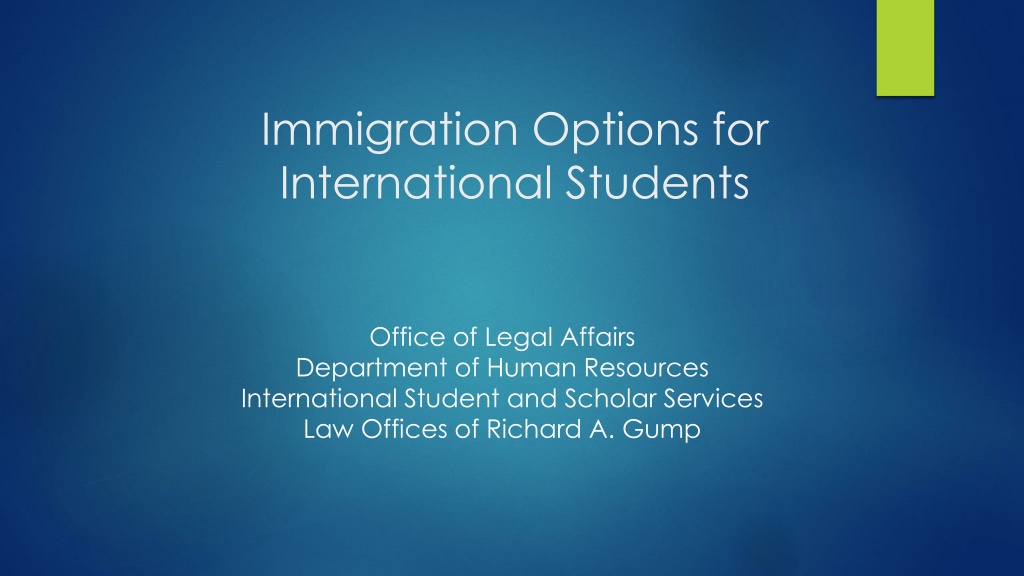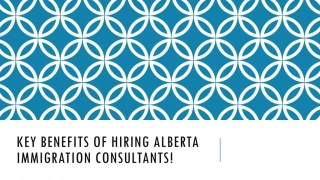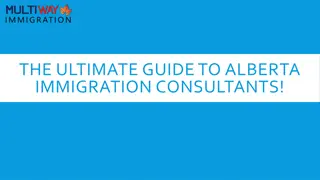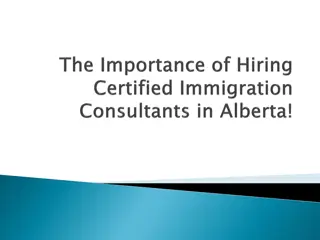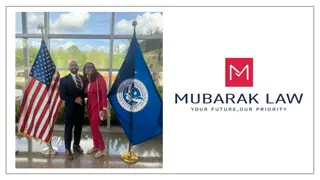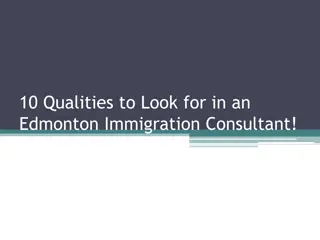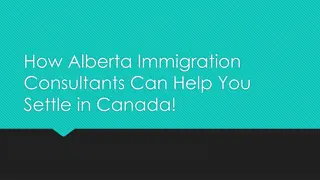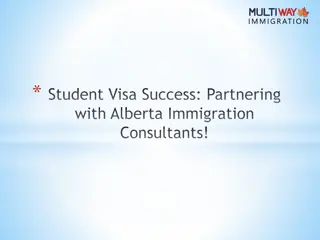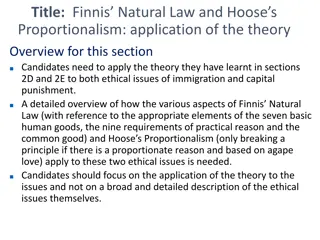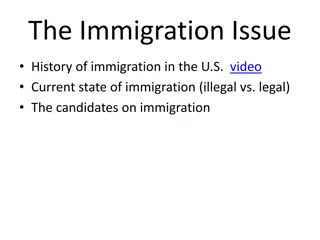Immigration Options for International Students
This guide covers various immigration options for international students including employment authorization, nonimmigrant and immigrant visa options, curricular practical training (CPT), optional practical training (OPT), and OPT-STEM extension. It explains the process, requirements, and limitations for international students seeking employment opportunities in the U.S.
Download Presentation

Please find below an Image/Link to download the presentation.
The content on the website is provided AS IS for your information and personal use only. It may not be sold, licensed, or shared on other websites without obtaining consent from the author.If you encounter any issues during the download, it is possible that the publisher has removed the file from their server.
You are allowed to download the files provided on this website for personal or commercial use, subject to the condition that they are used lawfully. All files are the property of their respective owners.
The content on the website is provided AS IS for your information and personal use only. It may not be sold, licensed, or shared on other websites without obtaining consent from the author.
E N D
Presentation Transcript
Immigration Options for International Students Office of Legal Affairs Department of Human Resources International Student and Scholar Services Law Offices of Richard A. Gump
Agenda Employment authorization for students Nonimmigrant visa options Immigrant visa options Hot topics Q & A
Employment Options for International Students Curricular Practical Training On-Campus Employment Economic Hardship Optional Practical Training and STEM
Curricular Practical Training (CPT) CPT is integral to the student s major and the experience must be part of the program of study. When a student enrolls at the graduate level, the designated school official (DSO) may authorize CPT during the student s first semester if the program requires this type of experience. Students will receive a new Form I-20, Certificate of Eligibility for Nonimmigrant Student Status, that shows that the DSO has approved CPT. CPT can be either full-time or part-time. CPT requires a signed cooperative agreement or a letter from the employer. If a student accumulates 12 months or more of full-time CPT, the student is ineligible for OPT.
Optional Practical Training (OPT) OPT must relate to the student s major or course of study. Students can apply for 12 months of OPT at each education level, (i.e., student s may have 12 months of OPT at the bachelor s level and another 12 months of OPT at the master s level). The DSO will provide a new recommendation for this employment. Students must submit a completed Form I-765, Application for Employment Authorization, to U.S. Citizenship and Immigration Services (USCIS) and pay a filing fee in order to obtain their Employment Authorization Document (EAD). Students may not start working until their receive their EAD. While school is in session, students are limited to 20 hours of work per week. Form I-20 that shows the DSO
OPT - STEM (Science, Technology, Engineering and Mathematics) Certain F-1 students who receive STEM degrees may apply for a 24-month extension of their post-completion OPT. The 24-month extension replaced the 17-month STEM OPT extension previously available to STEM students. Requirements for 24 month extension: Employer must be enrolled in E-Verify All material changes to the STEM OPT student s employment must be reported to the DS within five business days. Implement a formal training program to augment the student s academic learning through practical experience. Provide an OPT opportunity that is commensurate with those of similarly situated U.S. workers in duties, hours, and compensation. Complete Form I-983, Training Plan for STEM OPT Students
STEM (continued) Students who receive a 24 month STEM extension may not accrue an aggregate of more than 120 days of unemployment during the total 36 month OPT period. Students must have successfully completed a Bachelor s, Master s or Ph.D. program in a STEM field (listed in the DHS STEM Designated Degree program) from a college or university. Application for 24 month extension must be made at least 90 days before current OPT expires. Student must have maintained valid F-1 non-immigrant status. 24 month extension is only available once students may not receive multiple 24 month extensions even if a higher degree is earned.
Nonimmigrant Options H-1B Most commonly used nonimmigrant visa for employment in the U.S. Used by temporary (nonimmigrant) occupation. workers engaged in a specialty H-1B1 Available to citizens of Chile and Singapore E-3 Available to citizens of Australia TN Available to citizens of Mexico and Canada O-1 Individuals with Extraordinary Ability or Achievement L-1 Intracompany Transfer E-1/E-2 Treaty Traders and Treaty Investors
H-1B Category: USCIS Provisions H-1B visas are for temporary (nonimmigrant) workers engaged in a specialty occupation that requires (1) theoretical and practical application of highly specialized knowledge and (2) attainment of a bachelor s or higher degree, or equivalent experience, in the specific specialty for entry into the occupation H-1B Cap: 65,000 + 20,000 additional visas allocated to holders of advanced degrees from U.S. universities are available each fiscal year New fiscal year starts on October 1 Employers can submit H-1B petitions six months in advance Must apply on April 1 for a start date of October 1 Cap Subject vs. Cap Exempt Universities, Government Agencies, Nonprofit Organizations, and Hospitals are all cap exempt
Cap Gap Extension Cap-gap occurs when an F-1 student s work authorization expires in the fiscal year before they can start their approved H-1B employment on October 1. An interim final rule allows the F-1 status of students to be automatically extended when the student is the beneficiary of an H-1B petition for the next fiscal year. The extension terminates when USCIS rejects, denies or revokes the petition. The student benefits from this only if he or she has not violated their status. If a student s petition is rejected, denied or revoked, that student will then have the standard 60 day grace period from the date of the denial, rejection or revocation to depart the U.S. However, in the case of a denial, the student is not granted the 60 day grace period if they are found to have a status violation, additionally, if a finding of fraud or misrepresentation is discovered after approval, the same rule applies.
Typical H-1B Timeline 08/01/2017 07/31/2018 OPT Validity Dates 04/01/2018 Employer files cap subject H-1B petition 05/31/2018 Employer receives receipt notice indicating H-1B petition was accepted under the H-1B cap 06/30/2018 Student files 24 month OPT STEM extension since no decision received on H-1B petition and OPT will expire in 30 days 10/01/2018 Student begins working in H-1B status (if petition has been approved)
H-1B (continued) H-1B can be full-time or part-time H-1B workers are tied to their employer Cannot accept payment from any other source Can hold dual/concurrent H-1Bs with multiple employers H-1B visas are valid for 3 years and can be extended for an additional 3 year period (total time = 6 years) Previous stays in L-1 or H-1 status (but not L-2 or H-4 dependent status) count towards maximum period of stay Time spent outside of the U.S. does not count towards 6 year limit H-1B visas can be extended past the 6-year maximum in certain situations: 1 year Extension: If PERM has been filed at least 365 days prior to the date the H-1B expires 3 year Extension: If an I-140 has been approved, and foreign national cannot adjust status because priority date is not current (usually someone from China or India)
H-1B1 and E-3 H-1B1 Based on treaties the US has with Chile and Singapore, Chileans and Singaporeans have a fast-track option to receive an H-1B1 specialty occupation visa. The H-1B1 does not require a petition to be submitted to the USCIS. The foreign national applies for the visa directly at the U.S. Consulate. Of the 65,000 visas available each year to H-1B applicants, up to 6,800 visas are reserved for Chileans and Singaporeans E-3 - Applies only to nationals of Australia. Visa requirements are similar to H- 1B: Must be coming to the United States solely to perform services in a specialty occupation AND the specialty occupation requires theoretical and practical application of a body of knowledge in professional fields and at least the attainment of a bachelor's degree, or its equivalent, as a minimum for entry into the occupation in the United States.
Nonimmigrant NAFTA Professional (TN) Allows citizens of Canada and Mexico to work in the United States in prearranged business activities for U.S. or foreign employers Applicant is a citizen of Canada or Mexico. Profession is on the NAFTA list. Position in the United States requires a NAFTA professional. Applicant will work in a prearranged full-time or part-time job for an employer. Self employment is not permitted. Applicant has the qualifications, meeting the specific requirements, education, and/or experience, of the profession.
Employment Based Green Card Process
Employment-Based Categories EB-1: Researchers/Professors Executives)* EB-2: Advance-degree Professionals, Aliens of Exceptional Ability and National Interest Waiver** EB-3: Professional, Skilled & Unskilled workers*** Priority Workers (Extraordinary and Multinational Ability, Outstanding Managers or * Labor certification not required ** labor certification may be required *** labor certification required
3 Steps to the Green Card PERM (Labor Certification) I-140, Immigrant Petition for Alien Worker I-485, Application to Register Permanent Residence or Adjust Status
Step 1: PERM (Labor Certification) What is PERM? First of three step process to obtain a green card Employer must prove to the Department of Labor that it is unable to identify an able and available U.S. worker to fill an open position All fees associated with labor certification must be paid by employer (attorney fees, advertising costs)
EB-2 vs EB-3 EB-2 Job requires and the foreign national is a member of the professions holding an advanced degree U.S. academic or professional degree or a foreign equivalent degree above that of a Bachelor s degree (i.e. Master s or higher) OR U.S. Bachelor s degree or a foreign equivalent degree plus at least five years of progressively responsible experience in the specialty EB-3 Professional Job requires and foreign national holds at least a U.S. Bachelor s degree or foreign equivalent degree and who is a member of the professions EB-3 Skilled Worker Job requires and the foreign national has at least two years of post-secondary education, training and/or experience
PERM Timing PERM application processing times: Prevailing wage determination: 12-16 weeks Recruitment 45 60 days Cooling off period 30 days
2 Types of Labor Certifications Standard PERM: For all professional and non-professional positions other than teachers. Special Handling PERM: May only be used for college/university teaching positions.
Step 2: Form I-140 Petition After PERM approved, eligible to file Form I-140, Immigrant Petition for Alien Worker Must be filed within 180 days of PERM approval For petition to be considered for approval it must clearly document two key components: (1) Employer/Sponsor s ability to pay offered wage (2) Verify the requirements listed on the PERM application (education, experience, etc.)
Step 3: Form I-485, Application to Adjust Status (Green Card) Can file concurrently with Form I-140 if priority date is current Filing of Form I-485 gives applicant status to remain in the U.S. 90-120 days after filing, applicant receives work permit (EAD) and travel document (advance parole) if they filed Form I-765 and Form I-131 Biometrics occur 1-3 months after filing All employment based green cards now require an in-person interview prior to approval of green card application Current processing times are 9-12 months after filing Form I-485
Filing PERM while in F-1 Status Travel outside of the U.S. after a PERM has been certified and I-140 has been approved could result in foreign national s F-1 visa being revoked and entry into the U.S. refused (due to immigrant intent) Must maintain valid status throughout the entire green card application process In most categories, citizens of China and India will have a significant wait before they are able to apply for a green card
Senate Bill 4- Anti-Sanctuary Cities Law SB4 bans sanctuary city policies, which prohibit local law enforcement from sharing information about a person s immigration status with the federal government Local officers (including campus police) can ask about immigration status, if they choose to, but only during a lawful stop or arrest. But, local officers cannot stop someone solely to ask about immigration status. Local officers are not required to ask about immigration status they can choose not to ask. Local officers will not face any penalties if they chose not to ask about immigration status. If a local officer learns that someone is undocumented, he or she cannot arrest or continue to hold the person on that basis. The officer can provide that information to ICE, but is not required to do so and can choose not to. Local officials can be punished with jail time or fines if they endorse any policy that limits the enforcement of immigration laws
